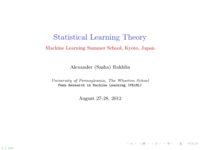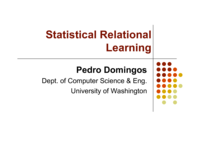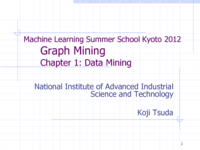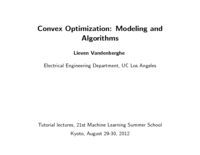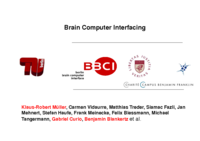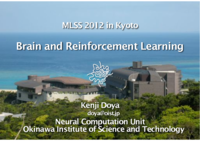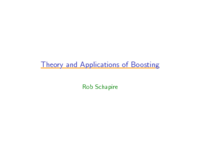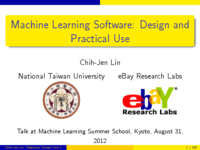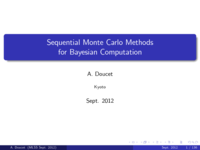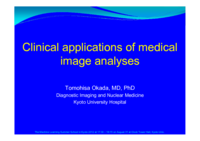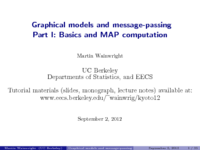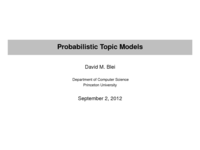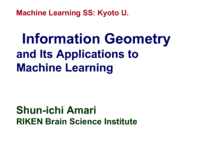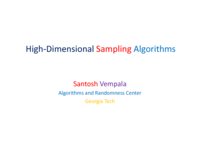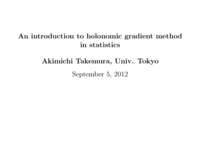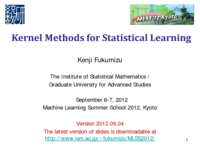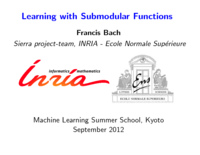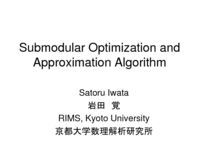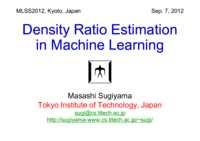Machine Learning Summer School Slides
These are slides from the talks and tutorials given at the 2012 Machine Learning Summer School in Kyoto, Japan (27 August – 7 September 2012). Slides are compiled from pdfs available here.
Statistical Learning Theory
Sasha Rakhlin
Abstract: The goal of Statistical Learning is to explain the performance of existing learning methods and to provide guidelines for the development of new algorithms. This tutorial will give an overview of this theory. We will discuss mathematical definitions of learning, the complexities involved in achieving good performance, and connections to other fields, such as statistics, probability, and optimization. Topics will include basic probabilistic inequalities for the risk, the notions of Vapnik-Chervonenkis dimension and the uniform laws of large numbers, Rademacher averages and covering numbers. We will briefly discuss sequential prediction methods.
Statistical Relational Learning
Pedro Domingos
Abstract: Most machine learning algorithms assume that data points are i.i.d. (independent and identically distributed), but in reality objects have varying distributions and interact with each other in complex ways. Domains where this is prominently the case include the Web, social networks, information extraction, perception, medical diagnosis/epidemiology, molecular and systems biology, ubiquitous computing, and others. Statistical relational learning (SRL) addresses these problems by modeling relations among objects and allowing multiple types of objects in the same model. This tutorial will cover foundations, key ideas, state-of-the-art algorithms and applications of SRL.
Graph Mining
Koji Tsuda
Abstract: Labeled graphs are general and powerful data structures that can be used to represent diverse kinds of objects such as XML code, chemical compounds, proteins, and RNAs. In these 10 years, we saw significant progress in statistical learning algorithms for graph data, such as supervised classification, clustering and dimensionality reduction. Graph kernels and graph mining have been the main driving force of such innovations. In this lecture, I start from basics of the two techniques and cover several important algorithms in learning from graphs. Successful biological applications are featured. If time allows, I will also cover recent developments and show future directions.
Convex Optimization
Lieven Vandenberghe
Abstract: The tutorial will provide an introduction to the theory and applications of convex optimization, and an overview of recent algorithmic developments. Part one will cover the basics of convex analysis, focusing on the results that are most useful for convex modeling, i.e., recognizing and formulating convex optimization problems in practice. We will introduce conic optimization and the two most widely studied types of non-polyhedral conic optimization problems, second-order cone and semidefinite programs. Part two will cover interior-point methods for conic optimization. The last part will focus on first-order algorithms for large-scale convex optimization.
Brain-Computer Interfacing
Klaus-Robert Müller
Abstract: Brain Computer Interfacing (BCI) aims at making use of brain signals for e.g. the control of objects, spelling, gaming and so on. This tutorial will first provide a brief overview of the current BCI research activities and provide details in recent developments on both invasive and non-invasive BCI systems. In a second part – taking a physiologist point of view – the necessary neurological/neurophysical background is provided and medical applications are discussed. The third part – now from a machine learning and signal processing perspective – shows the wealth, the complexity and the difficulties of the data available, a truely enormous challenge. In real-time a multi-variate very noise contaminated data stream is to be processed and classified. Main emphasis of this part of the tutorial is placed on feature extraction/selection, dealing with nonstationarity and preprocessing which includes among other techniques CSP. Finally, I report in more detail about the Berlin Brain Computer (BBCI) Interface that is based on EEG signals and take the audience all the way from the measured signal, the preprocessing and filtering, the classification to the respective application. BCI communication is discussed in a clinical setting and for gaming.
Neural Implementation of Reinforcement Learning
Kenji Doya
Abstract: The theory of reinforcement learning provides a computational framework for understanding the brain's mechanisms for behavioral learning and decision making. In this lecture, I will present our studies on the representation of action values in the basal ganglia, the realization of model-based action planning in the network linking the frontal cortex, the basal ganglia, and the cerebellum, and the regulation of the temporal horizon of reward prediction by the serotonergic system.
Theory and Applications of Boosting
Robert Schapire
Abstract: Boosting is a general method for producing a very accurate classification rule by combining rough and moderately inaccurate “rules of thumb.” While rooted in a theoretical framework of machine learning, boosting has been found to perform quite well empirically. This tutorial will focus on the boosting algorithm AdaBoost, and will explain the underlying theory of boosting, including explanations that have been given as to why boosting often does not suffer from overfitting, as well as interpretations based on game theory, optimization, statistics, and maximum entropy. Some practical applications and extensions of boosting will also be described.
Machine Learning Software: Design and Practical Use
Chih-Jen Lin
Abstract: The development of machine learning software involves many issues beyond theory and algorithms. We need to consider numerical computation, code readability, system usability, user-interface design, maintenance, long-term support, and many others. In this talk, we take two popular machine learning packages, LIBSVM and LIBLINEAR, as examples. We have been actively developing them in the past decade. In the first part of this talk, we demonstrate the practical use of these two packages by running some real experiments. We give examples to see how users make mistakes or inappropriately apply machine learning techniques. This part of the course also serves as a useful practical guide to support vector machines (SVM) and related methods. In the second part, we discuss design considerations in developing machine learning packages. We argue that many issues other than prediction accuracy are also very important.
Sequential Monte Carlo Methods for Bayesian Computation
Arnaud Doucet
Abstract: Sequential Monte Carlo are a powerful class of numerical methods used to sample from any arbitrary sequence of probability distributions. We will discuss how Sequential Monte Carlo methods can be used to perform successfully Bayesian inference in non-linear non-Gaussian state-space models, Bayesian non-parametric time series, graphical models, phylogenetic trees etc. Additionally we will present various recent techniques combining Markov chain Monte Carlo methods with Sequential Monte Carlo methods which allow us to address complex inference models that were previously out of reach.
Clinical Applications of Medical Image Analyses
Tomohisa Okada
Abstract: Advances in medical imaging modalities have given us enormous databases of medical images. There is much information to learn from them, but extracting information with bare eyes only is by no means an easy task. However, with wide-spread application of functional MRI, analysis methods of brain images that borrow from machine learning have also dramatically improved. I would like to present some examples of their clinical applications, to draw the interest of the audience and possibility encourage further work in the field of medical image processing.
Graphical Models and Message-passing: Some Introductory Lectures
Martin Wainwright
Abstract: Graphical models allow for flexible modeling of large collections of random variables, and play an important role in various areas of statistics and machine learning. In this series of introductory lectures, we introduce the basics of graphical models, as well as associated message-passing algorithms for computing marginals, modes, and likelihoods in graphical models. We also discuss methods for learning graphical models from data.
Probabilistic Topic Models
David Blei
Abstract: Probabilistic topic modeling provides a suite of tools for the unsupervised analysis of large collections of documents. Topic modeling algorithms can uncover the underlying themes of a collection and decompose its documents according to those themes. This analysis can be used for corpus exploration, document search, and a variety of prediction problems. My lectures will describe three aspects of topic modeling: Topic modeling assumptions Algorithms for computing with topic models Applications of topic models In (1), I will describe latent Dirichlet allocation (LDA), which is one of the simplest topic models, and then describe a variety of ways that we can build on it. These include dynamic topic models, correlated topic models, supervised topic models, author-topic models, bursty topic models, Bayesian nonparametric topic models, and others. I will also discuss some of the fundamental statistical ideas that are used in building topic models, such as distributions on the simplex, hierarchical Bayesian modeling, and models of mixed-membership. In (2), I will review how we compute with topic models. I will describe approximate posterior inference for directed graphical models using both sampling and variational inference, and I will discuss the practical issues and pitfalls in developing these algorithms for topic models. Finally, I will describe some of our most recent work on building algorithms that can scale to millions of documents and documents arriving in a stream. In (3), I will discuss applications of topic models. These include applications to images, music, social networks, and other data in which we hope to uncover hidden patterns. I will describe some of our recent work on adapting topic modeling algorithms to collaborative filtering, legislative modeling, and bibliometrics without citations. Finally, I will discuss some future directions and open research problems in topic models.
Information Geometry and its Applications to Machine Learning
Shun-Ichi Amari
Abstract: Information geometry studies invariant geometrical structures of a family of probability distributions, which forms a geometrical manifold. It has a unique Riemannian metric given by Fisher information matrix and a dual pair of affine connections which determine two types of geodesics. When the manifold is dually flat, there exists a canonical divergence (KL-divergence) and nice theorems such as generalized Pythagorean theorem, projection theorem and orthogonal foliation theorem hold in spite that the manifold is not Euclidean. Machine learning makes use of stochastic structures of the environmental information so that information geometry is not only useful for understanding the essential aspects of machine learning but also provides nice tools for constructing new algorithms. The present talk demonstrates its usefulness for understanding SVM, belief propagation, EM algorithm, boosting and others.
High-dimensional Sampling Algorithms
Santosh Vempala
Abstract: We study the complexity, in high dimension, of basic algorithmic problems such as optimization, integration, rounding and sampling. A suitable convexity assumption allows polynomial-time algorithms for these problems, while still including very interesting special cases such as linear programming, volume computation and many instances of discrete optimization. We will survey the breakthroughs that lead to the current state-of-the-art and pay special attention to the discovery that all of the above problems can be reduced to the problem of *sampling* efficiently. In the process of establishing upper and lower bounds on the complexity of sampling in high dimension, we will encounter geometric random walks, isoperimetric inequalities, generalizations of convexity, probabilistic proof techniques and other methods bridging geometry, probability and complexity.
Introduction to the Holonomic Gradient Method in Statistics
Akimichi Takemura
Abstract: The holonomic gradient method introduced by Nakayama et al. (2011) presents a new methodology for evaluating normalizing constants of probability distributions and for obtaining the maximum likelihood estimate of a statistical model. The method utilizes partial differential equations satisfied by the normalizing constant and is based on the Grobner basis theory for the ring of differential operators. In this talk we give an introduction to this new methodology. The method has already proved to be useful for problems in directional statistics and in classical multivariate distribution theory involving hypergeometric functions of matrix arguments.
Kernel Methods for Statistical Learning
Kenji Fukumizu
Abstract: Following the increasing popularity of support vector machines, kernel methods have been successfully applied to various machine learning problems and have established themselves as a computationally efficient approach to extract non-linearity or higher order moments from data. The lecture is planned to include the following topics: Basic idea of kernel methods: feature mapping and kernel trick for efficient extraction of nonlinear information. Algorithms: support vector machines, kernel principal component analysis, kernel canonical correlation analysis, etc. Mathematical foundations: mathematical theory on positive definite kernels and reproducing kernel Hilbert spaces. Nonparametric inference with kernels: brief introduction to the recent developments on nonparametric (model-free) statistical inference using kernel mean embedding.
Learning with Submodular Functions
Francis Bach
Abstract: Submodular functions are relevant to machine learning for mainly two reasons: (1) some problems may be expressed directly as the optimization of submodular functions and (2) the Lovasz extension of submodular functions provides a useful set of regularization functions for supervised and unsupervised learning. In this course, I will present the theory of submodular functions from a convex analysis perspective, presenting tight links between certain polyhedra, combinatorial optimization and convex optimization problems. In particular, I will show how submodular function minimization is equivalent to solving a wide variety of convex optimization problems. This allows the derivation of new efficient algorithms for approximate submodular function minimization with theoretical guarantees and good practical performance. By listing examples of submodular functions, I will also review various applications to machine learning, such as clustering or subset selection, as well as a family of structured sparsity-inducing norms that can be derived and used from submodular functions.
Submodular Optimization and Approximation Algorithms
Satoru Iwata
Abstract: Submodular functions are discrete analogues of convex functions. Examples include cut capacity functions, matroid rank functions, and entropy functions. Submodular functions can be minimized in polynomial time, which provides a fairly general framework of efficiently solvable combinatorial optimization problems. In contrast, the maximization problems are NP-hard and several approximation algorithms have been developed so far. In this lecture, I will review the above results in submodular optimization and present recent approximation algorithms for combinatorial optimization problems described in terms of submodular functions.
Density Ratio Estimation in Machine Learning
Masashi Sugiyama
Abstract: In statistical machine learning, avoiding density estimation is essential because it is often more difficult than solving a target machine learning problem itself. This is often referred to as Vapnik's principle, and the support vector machine is one of the successful realizations of this principle. Following this spirit, a new machine learning framework based on the ratio of probability density functions has been introduced. This density-ratio framework includes various important machine learning tasks such as transfer learning, outlier detection, feature selection, clustering, and conditional density estimation. All these tasks can be effectively and efficiently solved in a unified manner by estimating directly the density ratio without actually going through density estimation. In this lecture, I give an overview of theory, algorithms, and application of density ratio estimation.
